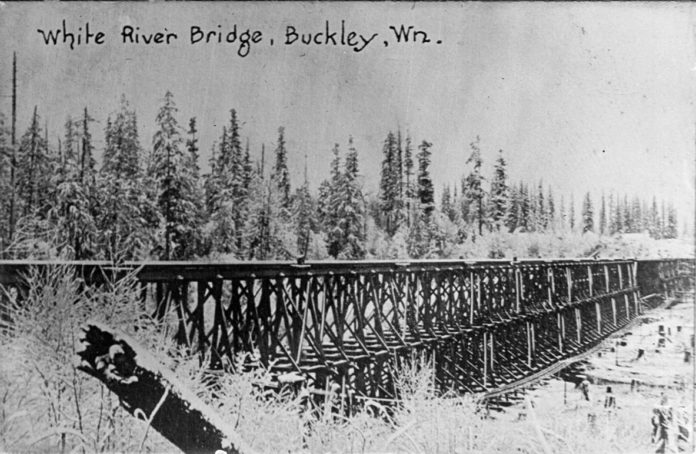The custom of sending Christmas cards began in England around 1843 from an idea of Sir Henry Cole. He helped set up the British Post Office and was looking for ways ordinary people might use it. Together with an artist friend, John Horsley, the two designed the first card with three panels – the outer two showing people caring for the poor and the center panel of a family having a large Christmas dinner. Christmas cards appeared in the U.S. a few years later but were expensive, until modern printing techniques lowered costs and they became widely available.
This snowy picture of the Northern Pacific Railroad over the White River was glued to a card reading “Greetings from Buckley, Wn.” The card was printed by Hopf Bros. Company of Seattle and probably dates to the early 1900s, as does the photo.
In 1864, Northern Pacific obtained a Congressional charter to build a transcontinental railroad from Minnesota to the Puget Sound along a northern route. In 1873, Northern Pacific announced Tacoma to be the railroad’s western terminus and the following year began construction of a rail line from Tacoma to Wilkeson to take advantage of newly discovered coal resources along the Carbon River. The railroad reached Yakima in 1886, but a 77-mile gap remained which threatened the millions of acres of land grants Northern Pacific was entitled to only when a direct rail line was completed.
Northern Pacific swung into action laying tracks from Buckley across the White River. From Enumclaw the tracks turned north into the upper Green River Valley, past Palmer-Kanaskat into dense forests towards Stampede Pass. From the east the railroad was extended though Ellensburg to the summit where Nelson Bennett constructed a 9,850-foot tunnel under Stampede Pass. On May 27, 1888, the first train passed through that tunnel providing a direct route to the Puget Sound. Railroad service was fundamental to the establishment of the new town of Enumclaw and the growth of nearby Buckley.
This railroad trestle was constructed about 1886 where Boise Creek flows into the White River. It was rebuilt several times due to washouts from flooding. This photo comes courtesy of JoAnne Matsumura, an Issaquah historian who also provided research into the greeting card upon which it appeared. Jean Contreras of the Foothills Historical Museum in Buckley supplied additional information about the history of the bridge. Next week, a story about E.L. Robinson who built a six-story tower near this bridge in the community called Boise.







